| Hanshinkan Kid (7): Cats Haruki Murakami's love for cats comes through in his works |
||
| @@@ | ||
|
Haruki Murakami is known for his fondness for cats because he frequently includes felines in his works.
In gMurakami Harukido wa ikanishite kitaeraretaka,h a collection of essays, Murakami tells an interesting story about a cat in its old age he once kept.
In a piece titled gChoju Neko no Himitsuh (The secret of an old cat), Murakami described how he asked a senior executive at Kodansha Ltd., a publishing company, to take care of his cat while he and his wife were away from home for a long period. In return, Murakami promised to the executive to write a novel for the company. The writer kept his promise and wrote gNorwegian Wood,h which turned out to be a phenomenal bestseller.
| ||
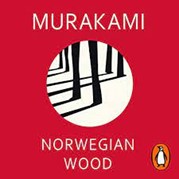 @ @ |
||
| Murakami named the cat gFuku Nekoh (Lucky Cat). In his childhood years, Murakami
would play at Nishinomiya Shrine in Nishinomiya, a city within the so-called "Hanshinkan" area between Osaka and Kobe. Ifm familiar with the shrine because it was also my favorite place to play when I was a child.
| ||
 @ @ |
||
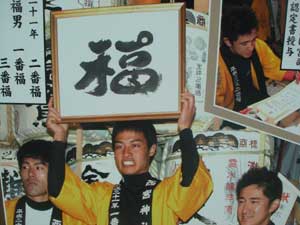 @ @ |
||
| Lucky Man(Fuku-Otoko)@race and the winner | ||
| As a Hanshinkan kid like Murakami, I suspect that the name the author gave to the cat was inspired by the famous gLucky Man(Fuku-Otoko)h race, held early on Jan. 10 as the main event of the shrinefs annual Toka-Ebisu festival. A legion of participants sprint perilously more than 200 meters from the shrinefs main gate to the main hall to be chosen as gLucky MeniFuku Otokoj.h
In the same essay, Murakami also describes how the cat was sitting on his lap while he was writing his debut novel, gHear the Wind Sing.h
gI still remember well the days when I was writing my first novel at night, with the cat on my lap and sipping beer. The cat apparently didnft like me writing a novel and would often play havoc with my manuscript on the desk.h
MISSING CAT, MISSING WIFE Unlike a dog, a cat kept as a pet in a house is not chained outside. While its whereabouts is often unclear, the furry animal occupies an important place in the ownerfs heart. If a cat, which always returns home even if it is away for a while, goes missing, that should be taken as an ominous sign indicating that something serious is going to happen. Such mysterious and symbolic felines often appear in Murakamifs novels in exquisite timing. In gThe Wind-up Bird Chronicle,h which revolves around the protagonistfs search for his missing wife, their cat runs away first, and then the woman mysteriously disappears as if prompted by the catfs disappearance. | ||
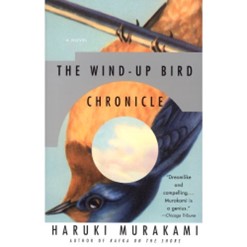 @ @ |
||
| Cats also play an important role in his long novel g1Q84,h which contains a tale about an imaginary gTown of Catsh where cats are the only residents. | ||
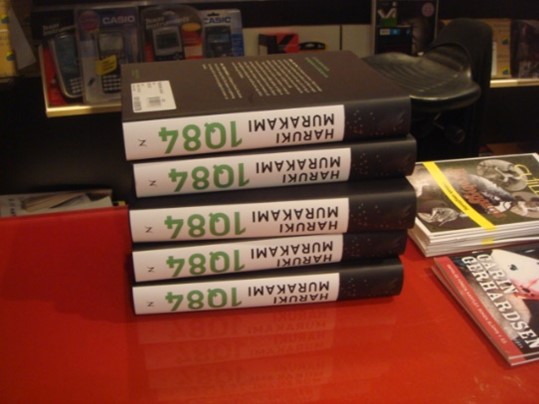 @ @ |
||
| A traveling young man gets off the train at a station and finds the town completely deserted, with no one to be seen. But it was, in fact, a town of cats. When the sun starts to go down, many cats comes into town and go about their business like human beings. When he attempts to take the train away from the town, the train doesnft stop at the town's station and passes by without slowing. The young man knows that he is irretrievably lost.
The New York Times applauded the fantastic description of the town of cats, while the New Yorker magazine carried an article only about this story. In the article, Murakami said the following:
" 'Town of Cats' is a story that I made up. I think I probably read something like it a long time ago, but I donft have a very precise recollection of whatever it was that I read. In any case, this episode performs a symbolic function in the novel in many different senses--the way a person wanders into a world from which he can never escape, the question of who it is that fills up the empty spaces, the inevitability with which night follows day. Perhaps each of us has his or her own 'town of cats' somewhere deep inside--or so I feel."
POSSIBLE INFLUENCE FROM NATSUME AND TANIZAKI | ||
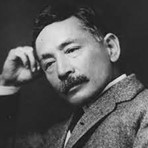 @ @ |
||
| Soseki Natsume, | ||
|
There are at least two famous Japanese writers who wrote stories about cats before Murakami. One is Soseki Natsume, whose gWagahai wa neko de aruh (I Am a Cat), depicts Japanese society and people during the Meiji Era (1868?1912) in a satirical way from the viewpoint of the speaker, which is an anthropomorphized domestic cat. | ||
 @ @ |
||
|
The other is Junichiro Tanizaki, who wrote gNeko to Shozo to futari no onnah (A cat, Shozo and two women), which describes how cats live their lives. It is arguably the best Japanese novel about cats ever written. In an open interview he gave in Kyoto in May 2013, Murakami said his favorite Japanese writers included Natsume and Tanizaki. One character in his gKafka on the Shore,h Satoru Nakata, is an old man who has lost the ability to read and write through a bizarre childhood incident but gained the ability to communicate with cats. This strange character probably reflects an influence from the two master. Both Tanizaki and Murakami once lived near the Shukugawa river, which runs through Nishinomiya. Located on both sides of the river, there is a hangout for stray cats in the Shukugawa Park.. They donft care at all for passers-by. Both Tanizaki and Murakami may have been intrigued by cats playing in the park and gotten some ideas for their works. | ||
 @ @ |
||
 @ @ |
||
| Cats in the Shukugawa Park. | ||
|
gFuwa Fuwah (Furry) is a picture book jointly created by Murakami, who wrote the text, and Mizumaru Anzai, who painted the pictures. Anzai died in March 2014. | ||
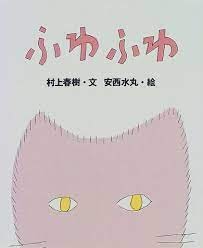 @ @ |
||
| Fuwa Fuwa | ||
| The book begins with this passage: gI like most cats around the world, but of all the kinds of cats living on this planet, I like an old, large she-cat the most.h
Even though gFuwa Fuwah is a picture book, it is not an easy read as the text is littered with Murakamiesque metaphors.
The cat was kept at a doctorfs house before it is given to the protagonist, a boy. But the cat returned to its former ownerfs house by crossing two railway lines and a river. The cat is then brought back to the boyfs house and given the uncatlike name gDantsu.h It eventually becomes the boyfs good pal.
If I assume Dantsu is modeled on a cat actually kept by Murakami, as it is believed, I, a Hanshinkan kid who has been living close to the Shukugawa river since my boyhood, cannot help but to think of an actual bridge and two train lines that the cat should have crossed--a stone bridge across the Shukugawa river and the Hanshin Electric Railway line and the JR Tokaido Main Line, which have railroad crossings and bridges in the area.
| ||
Copyright Since 2009 OFFICE ATSURO KAWAUCHI. All rights reserved.